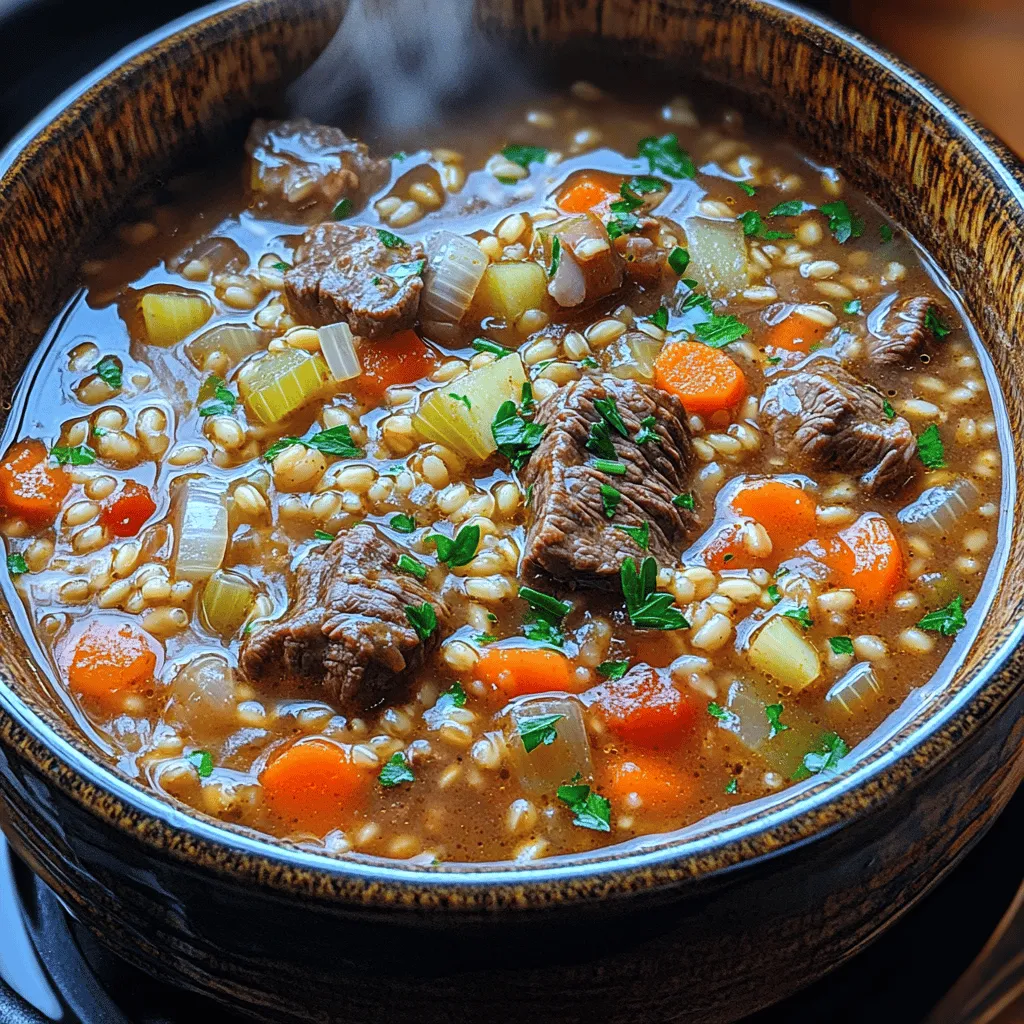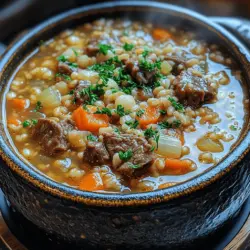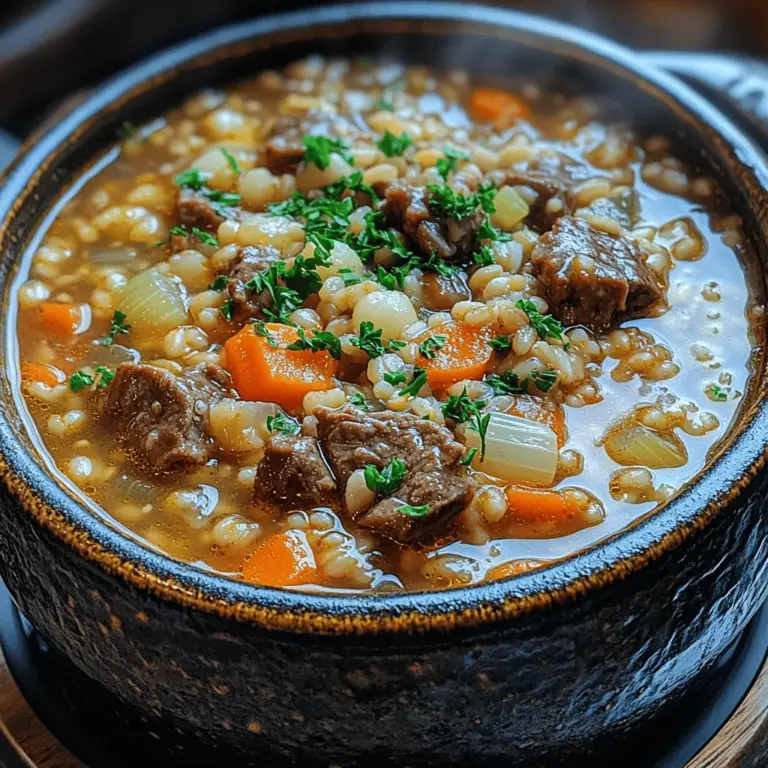Introduction
Hearty beef barley soup is a classic dish that embodies comfort and warmth, making it a favorite in homes around the world, especially during the colder months. Imagine a steaming bowl filled with tender pieces of beef, chewy pearl barley, and a medley of vegetables simmered to perfection. This soup not only satisfies hunger but also nurtures the soul, providing a sense of well-being with every spoonful.
The origins of beef barley soup can be traced back to various cultures, each adding its own unique twist. In Eastern European countries, it has long been a staple, often served in homes as a hearty meal to sustain families during long winters. The Scottish version, known as “Scotch broth,” includes lamb or mutton and is equally revered. The versatility of beef barley soup allows for adjustments that cater to regional tastes and available ingredients, yet the fundamental concept remains the same: a nourishing and filling dish that celebrates the bounty of simple, wholesome ingredients.
In crafting this soup, the importance of using quality ingredients cannot be overstated. The depth of flavor and nutritional value come from the freshness and quality of the meat, vegetables, and herbs used. When you opt for grass-fed beef, organic vegetables, and homemade beef broth, you elevate this humble dish into something truly special. It’s not just about feeding the body; it’s about creating a meal that resonates with love and care.
Understanding the Ingredients
Key Ingredients in Beef Barley Soup
To prepare a delicious beef barley soup, understanding the key ingredients is crucial. Each component contributes to the overall flavor and texture, making the soup a delightful experience.
Beef Stew Meat
The choice of beef is paramount in creating a rich and flavorful soup. For beef barley soup, the best cuts to use are typically tougher cuts such as chuck roast or brisket. These cuts are ideal for slow cooking because they contain more connective tissue, which breaks down during the simmering process, leading to tender, melt-in-your-mouth pieces of meat. When selecting beef, look for cuts that are well-marbled with fat; this fat renders during cooking, adding depth and richness to the broth.
Pearl Barley
Pearl barley is the star of this soup, providing a unique texture and heartiness that complements the beef. Unlike regular barley, pearl barley has been polished to remove the outer bran layer, making it quicker to cook and giving it a softer texture. Nutritionally, pearl barley is an excellent source of dietary fiber, protein, and essential vitamins and minerals. It not only helps to thicken the soup but also makes it more filling and nutritious.
Vegetables
The vegetables in beef barley soup play a pivotal role in flavor development. Onions and garlic form the aromatic base, providing a savory foundation. Carrots add a natural sweetness, while celery contributes a crisp texture and additional flavor. Mushrooms, whether button or cremini, introduce an earthy depth that enhances the overall profile of the soup. Each vegetable brings its own personality, and together, they create a harmonious blend that elevates the dish.
Herbs and Spices
Herbs and spices are essential for enhancing the flavors in beef barley soup. Fresh or dried thyme and rosemary add aromatic notes, while bay leaves contribute a subtle complexity to the broth. Salt and pepper are critical for seasoning and balancing the flavors. When combined, these herbs and spices create a fragrant, savory aroma that makes the kitchen feel inviting and warm.
Beef Broth
The broth serves as the foundation of the soup, providing moisture and flavor. Homemade beef broth is ideal, as it allows for complete control over the ingredients and seasoning. If time is a constraint, high-quality store-bought broth can also suffice. For those with dietary preferences, vegetable broth can be used as a base while still maintaining a hearty flavor. Ensuring that the broth is rich and well-seasoned is key to a successful beef barley soup.
Preparation Steps Explained
Browning the Beef
The first step in making hearty beef barley soup is to brown the beef. This technique is crucial for developing a rich, deep flavor profile. Begin by cutting the beef into bite-sized pieces and patting them dry with paper towels. Moisture on the surface can hinder browning, so ensuring the meat is dry will help achieve that coveted crust.
In a large pot or Dutch oven, heat a combination of oil and butter over medium-high heat. Once the fat is shimmering, add the beef in batches to avoid overcrowding the pot. Allow the beef to sear undisturbed for a few minutes until a golden-brown crust forms. This caramelization not only enhances the flavor of the meat but also contributes to the overall richness of the soup. Once browned, remove the beef and set it aside, allowing it to rest while you prepare the vegetables.
Sautéing the Vegetables
With the beef set aside, it’s time to sauté the vegetables. In the same pot, add a bit more oil if necessary, and toss in the chopped onions and minced garlic. Sauté these aromatics until the onions are translucent and fragrant, about 3-4 minutes. This step is essential, as it creates a flavorful base for the soup.
Next, add the diced carrots and celery, continuing to cook until they begin to soften, approximately 5 minutes. The key here is to allow the vegetables to caramelize slightly; this deepens their flavor and adds sweetness to the broth. If you choose to include mushrooms, add them towards the end of the sautéing process, as they release moisture and should be cooked just until tender.
Combining Ingredients
Once the vegetables are sautéed to perfection, it’s time to combine them with the beef. Return the browned beef to the pot, stirring everything together. Here, you can also add in the pearl barley, ensuring it is well distributed among the meat and vegetables.
Next, pour in the beef broth, ensuring that all ingredients are submerged. If you need to adjust the liquid levels, feel free to add a little more broth or water, but keep in mind that the barley will absorb some of the liquid as it cooks. This is also the moment to add your herbs and spices—thyme, rosemary, bay leaves, salt, and pepper. Stir gently to incorporate all the flavors, creating a cohesive mixture that will simmer beautifully.
Simmering
Simmering is where the magic happens. Bring the pot to a gentle boil, then reduce the heat to low and cover. Allow the soup to simmer for at least 1.5 to 2 hours. This slow cooking process is critical for tenderizing the meat and allowing the barley to absorb the flavors of the broth. During this time, the heat breaks down the tough connective tissues in the beef, resulting in a tender and flavorful outcome.
As the soup simmers, the aromas will fill your kitchen, creating an inviting atmosphere. Keep an eye on the liquid levels; if it seems to be reducing too much, add a splash more broth or water to maintain the desired consistency.
Final Seasoning Adjustments
Towards the end of the cooking time, taste the soup and adjust the seasoning as necessary. You may find that it needs a pinch more salt or a dash of pepper to brighten the flavors. If you prefer a more pronounced herb flavor, consider adding a bit more fresh thyme or rosemary at this stage.
Once the soup has finished simmering, you can remove the bay leaves and serve it hot, garnished with fresh parsley for a pop of color and freshness.
As you take that first spoonful of hearty beef barley soup, you’ll be met with a warm embrace of flavors, each ingredient working in harmony to create a dish that is both satisfying and nourishing.
By following these detailed preparation steps, you ensure that your beef barley soup is a success, capturing the essence of comfort food while offering a nutritious meal that can be enjoyed by everyone.

Protein from Beef
Beef is not only a staple in hearty beef barley soup but also a fantastic source of high-quality protein. Protein plays a crucial role in building and repairing tissues, making it essential for overall health. When you choose cuts of beef like chuck or brisket for this soup, you benefit from a rich flavor that deepens as it cooks, creating an irresistible broth. The beef in this soup provides not just protein but also iron, zinc, and B vitamins, all of which contribute to energy production and immune function. Pairing this with barley and vegetables creates a well-rounded dish that satisfies hunger while nourishing the body.
Fiber and Vitamins from Barley and Vegetables
Barley, a key ingredient in beef barley soup, is a whole grain packed with dietary fiber, which is vital for digestive health. Fiber helps regulate blood sugar levels, lowers cholesterol, and keeps you feeling full longer. Alongside barley, the array of vegetables—like carrots, celery, and onions—adds vitamins A, C, and K, plus essential minerals. These nutrients not only enhance the soup’s flavor but also boost its health benefits, making it a nutritious choice for any meal.
Comparison to Other Hearty Soups and Stews
When comparing beef barley soup to other hearty soups and stews, it stands out for its unique combination of flavors and textures. Unlike creamy soups or broths that may leave you wanting more substance, beef barley soup is filling thanks to the chewy barley and tender chunks of beef. It offers a heartiness that rivals dishes like beef stew or chicken noodle soup but with a distinctively robust flavor profile that is comforting and satisfying. This makes it a versatile dish that can be enjoyed on its own or as part of a larger meal.
Serving Suggestions
To elevate your beef barley soup experience, consider these serving suggestions:
1. Ideal Accompaniments: Pair your soup with crusty bread, such as a fresh baguette or sourdough. The crusty exterior and soft interior of these breads make them perfect for dipping in the hearty broth.
2. Types of Bread: Besides baguettes, other excellent choices include whole grain or rye bread, which adds its own flavor and texture. For a twist, try garlic bread or focaccia for a more aromatic experience.
3. Salads and Appetizers: To complement the rich flavors of beef barley soup, consider a light side salad with mixed greens, cherry tomatoes, and a simple vinaigrette. A classic Caesar salad or a cucumber and feta salad also works beautifully. For appetizers, serve a platter of roasted vegetables or a cheese board with assorted cheeses and crackers.
4. Presentation Tips: When serving beef barley soup, consider using rustic bowls or deep plates to enhance the dish’s hearty appeal. Garnish each bowl with fresh herbs, like parsley or thyme, for a pop of color and added flavor. Presenting the bread on a wooden board alongside the soup can create an inviting dining atmosphere.
Storing and Reheating Instructions
To make the most of your beef barley soup and enjoy it later, follow these storage and reheating tips:
1. Best Practices for Storing Leftovers: Allow the soup to cool completely before transferring it to storage containers. This prevents condensation, which can lead to spoilage.
2. Recommended Storage Containers: Use airtight containers or glass jars to store your soup. If you plan to freeze it, opt for freezer-safe containers or heavy-duty freezer bags, leaving some space for expansion as the soup freezes.
3. How Long the Soup Lasts: In the refrigerator, beef barley soup can be stored for up to three to four days. If you freeze it, it can last for three to six months, retaining its flavor and texture.
4. Reheating Methods: To reheat the soup, you can use the stove or microwave. For the stove, heat it over medium heat until warmed through, stirring occasionally. If using a microwave, transfer the soup to a microwave-safe container, cover it loosely, and heat in 1-minute intervals until hot. Avoid boiling the soup again, as this can change the texture of the barley and meat.
Variations and Customizations
One of the joys of cooking is the opportunity to customize recipes to suit your dietary needs or preferences. Here are some creative variations for your beef barley soup:
1. Dietary Modifications: If you’re looking to reduce red meat intake, consider using chicken or turkey instead of beef. Both options will still provide a hearty meal while being lower in fat.
2. Alternative Proteins: For a plant-based option, substitute the beef with lentils or chickpeas. This not only caters to vegetarians or vegans but also adds a unique texture and flavor profile to the soup.
3. Gluten-Free Options: For those avoiding gluten, you can easily replace barley with quinoa or brown rice. Both alternatives provide a similar texture and nutritional benefits without the gluten.
4. Creative Add-Ins: Boost the nutritional value of your soup by adding a variety of vegetables or legumes. Consider incorporating spinach, kale, or sweet potatoes for added vitamins and minerals. Beans, like kidney or black beans, can also add protein and fiber, making the dish even more filling.
Conclusion
Hearty beef barley soup is not just a dish; it’s a comforting embrace on a cold day, a nutritional powerhouse, and a celebration of wholesome ingredients. With its rich flavors, satisfying texture, and nourishing qualities, this soup makes for an exceptional meal that brings families together.
As you prepare to try this recipe, remember the joy of homemade cooking. There’s something truly special about creating a pot of soup that not only warms the body but also fills the heart. Whether served at a family gathering or enjoyed as a simple weeknight dinner, beef barley soup has a place in any kitchen. So gather your ingredients, embrace the cooking process, and savor the delightful flavors that await in each hearty spoonful.

